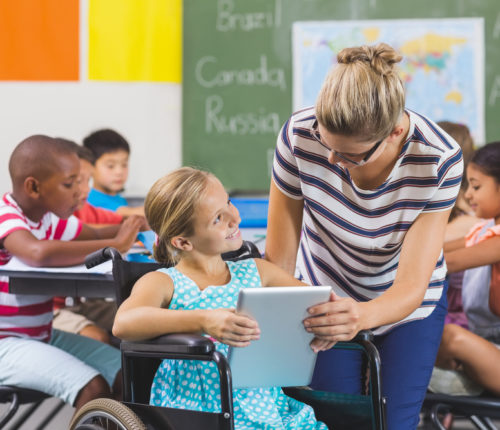
Assistive Technology Programs
According to the United States Department of Education (DoE), assistive technology programs and devices for infants, toddlers and children are on the rise. This is partially due to the benefits these types of programs offer to people with disabilities and disorders. This includes individuals with birth injuries. It is also in part due to the Individuals with Disabilities Education Act (IDEA).
What Are Assistive Technology Programs And What Do They Do?
Assistive technology programs for infants and children are both non-profit and private programs that assist those with disorders and disabilities. These programs are designed to enhance children’s abilities to interact as independently as possible with other individuals and their environment. The disorders of children who use assistive technology range in severity. Some diagnoses include cerebral palsy, brain damage, brachial plexus injury and more. There are currently assistive technology programs available in every state in the nation.
There are a numbers of ways assistive technology programs help benefit special needs infants and children. According to the National Assistive Technology Technical Assistance Partnership (NATTAP), the most common types of services include:
- Physical therapy
- Occupational therapy
- Nutrition
- Speech-language pathology services
- Medical services
Under the amended Assistive Technology Act of 1998, there are currently 56 state and territory-funded public programs. Assistive technology (AT) is defined as any device that helps improve and enhance the lives of babies and children with disabilities. These products include:
- Specialized learning materials
- Software
- Wheelchairs
- Braces
- Pencil holders
- Power lifts
In other words, AT products help with important skills and abilities, including:
- Reading
- Walking
- Hearing
- Writing
- Communicating
- Eating
AT products can, essentially, help with any daily activity that people with disabilities need assistance with.
Choosing the Correct Assistive Technology Program for Your Baby or Child
It’s important to note that there are a few options when choosing the right program for your infant or child. The most common programs include:
- The American Occupational Therapy Association (AOTA)
- Council for Exceptional Children (CEC)
- American Speech/Language/Hearing Association (ASHA)
- Learning Disabilities Association of America (LDA)
- Rehabilitation Engineering and Assistive Technology Society of North America (RESNA)
Under the Individuals with Disabilities Education Act (IDEA), qualified infants and children can receive free assistance under the Free Appropriate Public Education (FAPE). Any child under the age of 21 who has one or more disabilities usually qualifies for assistance under IDEA. In addition, public schools in the United States must develop an Individualized Family Service Plan (IFSP) for each student with a disability.
It is generally a collaborative effort from the child’s professional team to try and select the most appropriate and beneficial technology program to most efficiently meet your child’s needs. For example, a teacher, therapist, dietician, counselor and other professionals will all work together to help the family and child decide on the correct program(s).
How Are Assistive Technology Programs Funded?
Funding greatly depends on the individual program. For example, programs that provide educational services to students may be funded by local schools, whereas other forms of government assistance may fund programs for toddlers and infants. Depending on the state you live in, there may also be private and/or charitable organizations that fund local programs.
In many instances, families who need these programs generally do not have to pay, and if so, the cost is usually minimal. However, these programs change constantly, so it’s important to understand what may have been covered previously may not currently be covered.
Often times private insurance companies assist with the funding of assistive technology programs. Your physician and/or insurance provider should be able to give you additional details.
How Do Assistive Technology Programs Specifically Help Infants and Toddlers?
Infants and toddlers, although they may not have mastered skills such as using a keyboard or computer yet, can still greatly benefit from assistive technology programs. Recent research shows that infants and toddlers do not need to master the use of certain equipment before benefiting from them. For instance, from simply using a touch screen tablet, many toddlers have been able to learn to effectively communicate and reach milestones they may have otherwise not have been able to meet.
For toddlers who have limited speech and difficulties with oral communication, augmentative communication devices can help them learn to communicate more effectively. In addition, using technological devices early in life can help babies and children use more intricate and advanced devices as they grow older.
Physically, babies and toddlers can benefit from an array of devices that are utilized to assist with meeting motor milestones such as crawling, sitting up, walking and exploration.
Many lifelong skills are initially developed during the infancy phase. Yet, babies with physical or cognitive disabilities typically have a more difficult time developing crucial skills. AT products and programs can help bridge the gap and assist babies in learning developmentally appropriate life long skills.
How to Find an Assistive Technology Program in Your Area
For more information on IDEA and to see if your child qualifies for these services, contact your local school board or your child’s school. Babies and toddlers who do not yet qualify for IDEA, contact the United States Assistive Technology Program (ATP) at 415-455-4575. For information on birth injuries or if you have concerns, feel free to contact us 877-415-6603.
How to Learn More About Assistive Technology Programs
Since 1999, Assistive Technology Industry Association (ATIA) conferences have been held each year in order to help promote awareness and education of assistive technology programs. These conferences allow people from all across the world, not only to learn more about these programs, but to also get hands-on experience in how different types of devices and equipment work. These conferences are appropriate for professional practitioners, teachers, parents and caregivers in addition to the individuals with the disability.
Often times, parents are better able to make informed decisions on the type of program that will benefit their children best by testing out equipment and seeing how they are utilized in person. In addition, parents can meet others who are in similar situations and can offer support, recommendations and advice.



